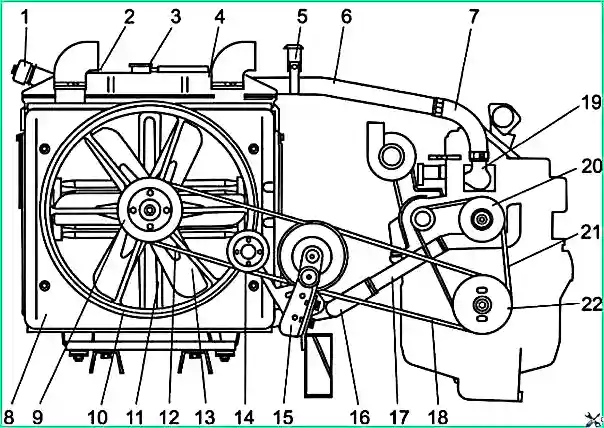Diesel cooling is liquid with forced circulation of coolant from a centrifugal pump. The design of the cooling system is shown in Figure 1

Cooling system: 1- filler plug; 2 - expansion tank; fan; 3 - upper radiator cap; 4 - radiator; 5 - pipe mounting bracket; 6 - radiator supply pipe; 7, 16 - pipe; 8 - fan casing; 9 - fan shaft pulley; 10 - fan drive housing; 11 - fan casing mounting frame; 12 - fan shaft drive belt; 13 - fan; 14 - tension roller; 15 - intermediate support bracket; 17 - outlet pipe; 18 - intermediate shaft drive belt; 19 - thermostat housing; 20 - water pump pulley; 21 - drive belt for the water pump and generator; 22 - crankshaft pulley
The temperature of the coolant in the cooling system must be maintained within (85-95) °C.
It is allowed to increase the coolant temperature to plus 105 °C during short-term (no more than 20 minutes) operation at maximum torque.
The temperature of the coolant in the system is controlled by a remote thermometer, the sensor of which is installed in the cylinder head.
Attention! It is prohibited to operate a diesel engine when the coolant overheating lamp comes on.
Thermostat with solid filler is designed to accelerate engine warm-up after starting and automatically regulate temperature conditions at different loads and ambient temperatures.
The temperature at which the thermostat begins to open is (85-89) °C.
The expansion tank is designed to compensate for changes in the volume of coolant when it is heated and to remove air.
The water pump and generator are driven from the engine crankshaft pulley through two V-belts.
The engine cooling system fan is driven from the crankshaft pulley through the intermediate support pulley.
Cooling system maintenance
When servicing the cooling system, the fluid level in the expansion tank is checked daily and the tightness of the connections is monitored.
It is not allowed to operate a bus with an empty expansion tank. The liquid level should be near the middle of the tank.
A low-freezing liquid should be used as a coolant in the system.
The density of the low-freezing liquid should be monitored before the start of the cold season, as well as after each repair of the cooling system associated with a coolant leak.
External signs (color, smell, etc.) do not allow you to correctly determine the quality of the coolant.
Once a year in the fall, when performing seasonal maintenance, the coolant should be replaced.
Before replacing the fluid, you need to make sure the system is tight.
Attention! The use of coolant of insufficient density can cause destruction of the diesel engine.
Attention! Starting and operating a diesel engine with an empty cooling system is prohibited.
The tension of the fan belt between the crankshaft pulley and the intermediate support is performed by turning the eccentric axis of the intermediate support after loosening the nuts securing it.
The tension of the belt between the fan pulleys and the intermediate support is carried out by a tension roller.
Tension control is carried out using a spring dynamometer based on the amount of belt deflection.
Belt deflection under load (40±2) N should be:
- - in the area between the crankshaft pulleys and the intermediate support - (14-20) mm;
- - in the area between the intermediate support pulleys and the fan shaft – (13-18) mm.
The bearings of the water pump, fan shaft and intermediate fan support do not require lubrication during the entire period of operation.
Litol-24 lubricant is placed in the bearing cavity of the water pump during assembly and is replaced only after repair (disassembly) of the unit.
To maintain optimal engine thermal conditions at low temperatures, all radiator hatch grilles should be covered with insulation, and if necessary, remove the fan drive belt.





